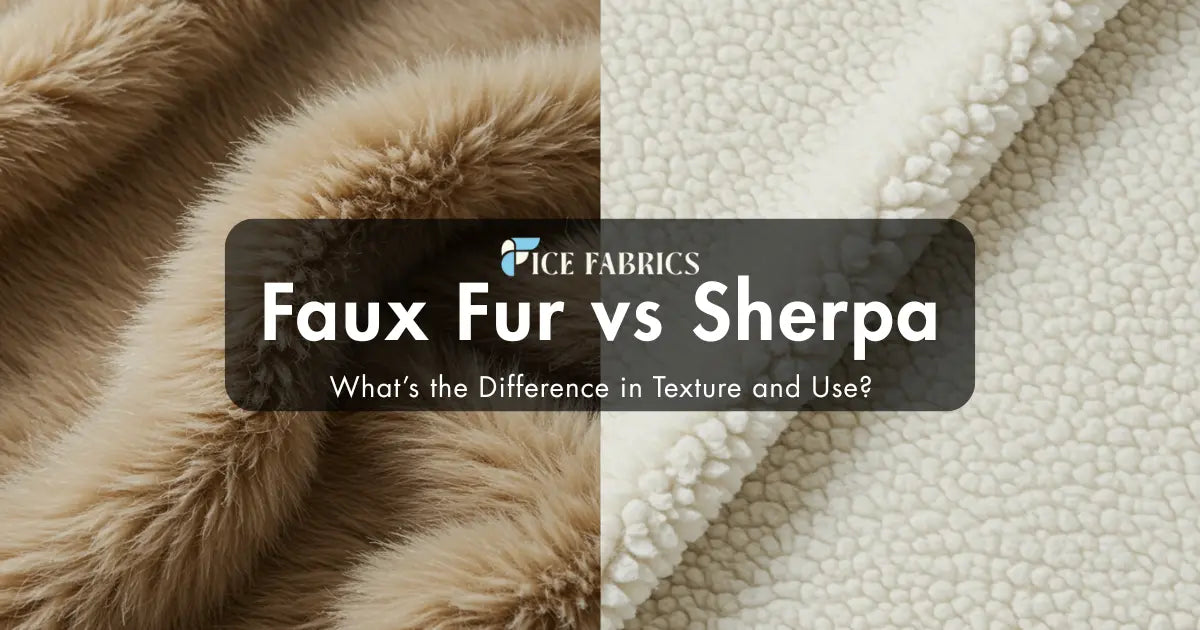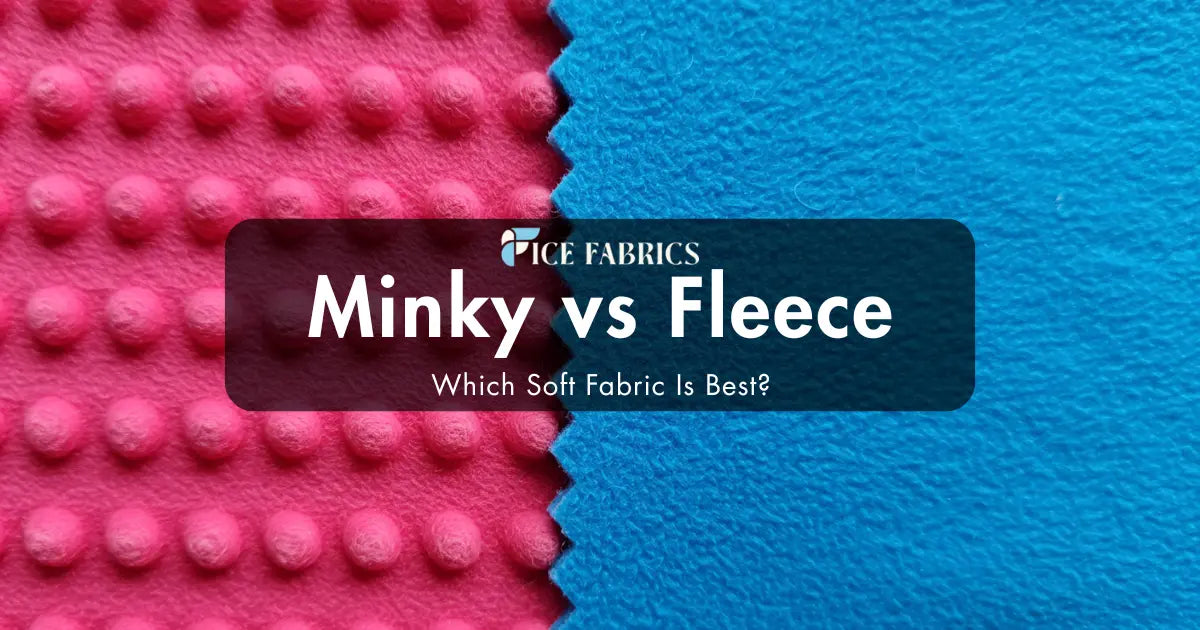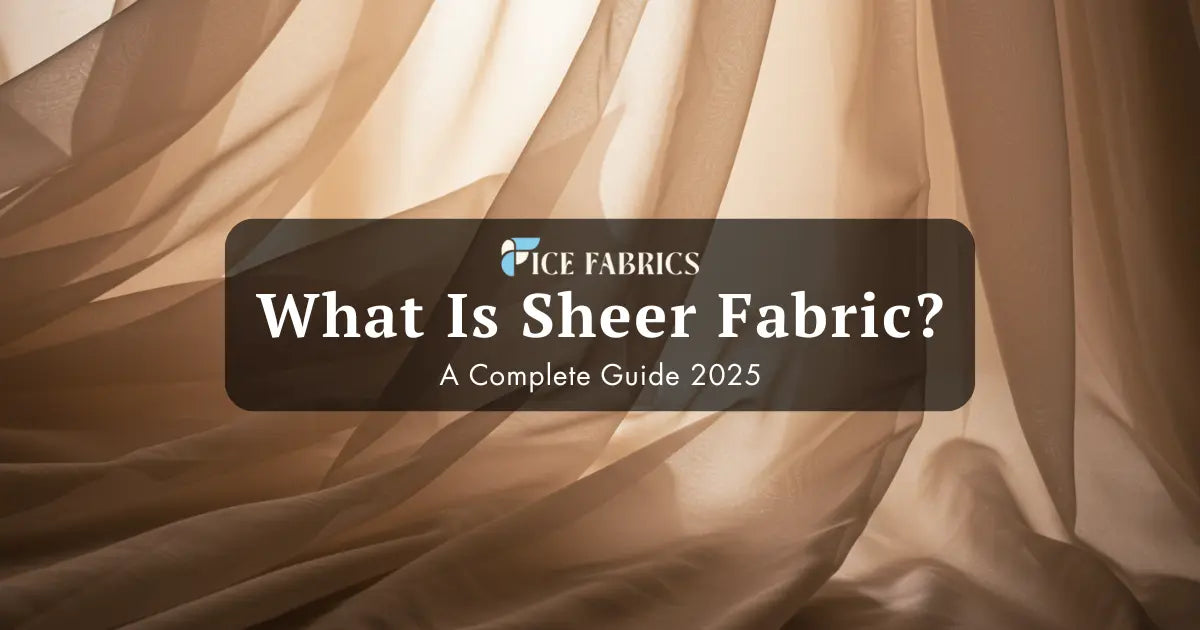When shopping for cozy fabrics whether for clothing, blankets, or upholstery—you’ve probably come across faux fur and sherpa fabric. These two soft and warm materials are popular in everything from winter coats to throw pillows. But while they may look similar at first glance, they’re actually quite different in texture, construction, and usage.
In this guide, we’ll take a close look at the differences between faux fur and sherpa, helping you understand which fabric is better for your next sewing project or product design. We’ll also explore how both fabrics are made, how they feel, how they’re used, and where you can buy faux fur fabric by the yard or sherpa material by the roll at wholesale prices.
A Tale of Two Cozy Fabrics
Both faux fur and sherpa are designed to mimic the warmth and softness of natural wool or animal fur, but they do so in very different ways. Faux fur is meant to resemble animal fur and has a longer, fluffier pile, while sherpa fabric mimics sheepskin or lamb’s wool and has a curly, soft texture.
Before you decide which fabric is right for your needs, let’s explore each one in more detail.
What Is Faux Fur?
Faux fur, also known as fake fur or artificial fur, is a synthetic fabric made to look and feel like real animal fur. It’s usually made from materials like polyester, acrylic, or modacrylic. The fibers are woven or knitted into a backing to create a soft, fluffy pile.

Key Features of Faux Fur Fabric:
- Long, plush pile
- Soft and luxurious texture
- Comes in a wide variety of colors and patterns
- Often used as a cruelty-free alternative to real fur
Popular Types of Faux Fur Fabric:
- Shaggy faux fur: Long, wild-looking fibers
- Mink-like faux fur: Short and velvety, like mink
- Curly faux fur: Resembles curly wool
- Animal print faux fur: Designed to mimic specific animals like leopard or fox
You can find faux fur fabric by the yard or faux fur fabric by the roll for larger projects. Many stores also offer faux fur fabric wholesale, making it affordable for upholstery makers, fashion designers, and DIY enthusiasts.
What Is Sherpa Fabric?
Sherpa fabric is a type of fleece that resembles the wool-lined clothing traditionally worn by the Sherpa people of Nepal. Despite its name, most modern sherpa material is made from synthetic fibers like polyester. It features a soft, fluffy pile on one side and a smooth knit or woven back on the other.

Key Features of Sherpa Fabric:
- Resembles real sheep’s wool
- Lightweight and very soft
- Often used for linings, hoodies, baby items, and winter accessories
- Less expensive than faux fur
You’ll often find sherpa fabric by the yard available in neutral or earthy tones. It’s a popular choice for casual, cozy styles and is also used as sherpa upholstery fabric for throws, cushions, and blankets.
Curious how faux fur compares to other luxurious fabrics? Don’t miss our in-depth guide on Faux Fur Fabric by the Yard vs. Faux Mink: What’s the Difference?
Texture Comparison: Faux Fur vs. Sherpa
The most noticeable difference between faux fur and sherpa is texture.
Faux Fur:
- Longer, more dramatic fibers
- Feels soft, silky, and luxurious
- Often has a shiny appearance
- Some versions mimic the look of specific animals (e.g., fox, rabbit)
Sherpa:
- Shorter, curly or nubby texture
- Feels fuzzy and wool-like
- More casual and matte in appearance
- More consistent in texture than faux fur
If you're aiming for a high-fashion, glamorous look, faux fur is the clear winner. But if you want something cozy, lightweight, and functional, sherpa is a great pick.
Warmth and Insulation
Both faux fur and sherpa are known for their warmth, but they differ in performance:
-
Faux fur fabric tends to be heavier and offers more insulation due to its dense pile. It’s perfect for winter coats, vests, and throws in cold climates.
-
Sherpa material, while still warm, is generally lighter. It’s often used as a lining inside jackets, hoodies, and slippers to trap body heat without bulk.
When choosing between the two, think about your climate and how much warmth you really need.
Practical Uses and Applications
Both faux fur and sherpa fabric offer exceptional comfort and visual appeal, but they shine in different settings. Their unique textures and properties make them ideal for a wide range of uses in fashion, home décor, crafting, and pet products.
Common Uses of Faux Fur
Faux fur fabric is synonymous with style and softness. It mimics the look and feel of real animal fur but is made from synthetic materials like acrylic, polyester, or modacrylic. Its dramatic texture and visual richness make it a top choice in the fashion industry, interior design, and costume making.

1. Winter Fashion: Stylish and Warm
Faux fur is a classic staple in cold-weather fashion. Designers and crafters alike use it to create jackets, coats, vests, scarves, and boots that are both fashionable and functional. The plush texture and thick pile provide excellent insulation, making it ideal for winter wear. Whether you prefer a full faux fur coat or just faux fur trim on a hood, it adds instant elegance to any outfit.
For custom pieces or fashion lines, many turn to faux fur fabric by the yard in a wide variety of textures and colors ranging from neutral mink-like tones to bold dyed finishes. This makes it a versatile option for both casual and high-fashion outerwear.
2. Home Décor: Cozy Elegance
When it comes to interior design, faux fur fabric is used to create cozy, luxurious spaces. It’s often seen in throw blankets, decorative pillows, and even area rugs, bringing warmth and tactile beauty to bedrooms and living rooms.
For home décor projects, buyers can choose faux fur fabric wholesale or faux fur fabric by the roll to cover multiple rooms or coordinate colors across different furnishings. It’s particularly popular in winter or holiday-themed interior styling, where the aim is to create a soft, inviting atmosphere.
3. Upholstery: Luxe Statement Pieces
Faux fur has also carved out a space in the world of upholstery and furniture design. It's used on ottomans, benches, stools, and accent chairs, often as a bold texture contrast to sleek or industrial pieces.
Faux fur upholstery fabric offers both comfort and an upscale aesthetic, making it a great choice for glam interiors or boutique spaces. It’s not just about looks—faux fur adds a tactile, comforting quality to furniture, especially in bedrooms and lounges.
4. Costumes and Cosplay: Creative Flexibility
For those in theater, film, or cosplay, faux fur is a must-have material. Its soft yet durable fibers are ideal for creating everything from animal costumes to fantasy characters. Faux fur can be dyed, shaped, and trimmed, making it highly customizable for any look.
Artists and costume designers often rely on faux fur fabric by the yard for crafting maned hoods, fur capes, gloves, hats, and full-body suits. It’s also widely used for mascots, puppets, and whimsical children’s costumes.
Common Uses of Sherpa Fabric
Sherpa fabric is best known for its soft, curly pile that mimics lamb’s wool. While it's most often made from polyester, some high-end versions use sherpa wool blends. Its lightweight warmth and breathability make it ideal for layering and casual comfort.
Thanks to its fuzzy texture and softness, sherpa material is popular in both fashion and home essentials.

1. Casual Wear: Everyday Comfort
Sherpa is a favorite in laid-back fashion, commonly used as lining or exterior fabric in pullovers, sweatshirts, jackets, and loungewear. The fabric provides excellent insulation without the weight of traditional wool, making it ideal for fall and winter garments.
You’ll find sherpa-lined coats with denim or cotton exteriors, as well as full sherpa zip-up hoodies and fleece joggers that are perfect for chilly mornings or cozy evenings. For those making their own garments, sherpa fabric by the yard allows for full creative freedom and custom fits.
2. Children’s Clothing: Soft and Gentle on Skin
Sherpa is particularly suitable for baby and children’s clothing due to its fluffy softness and gentle feel. It’s commonly used to make baby blankets, mittens, hats, and outerwear for infants and toddlers. Since most sherpa material by the yard is hypoallergenic and non-irritating, it's ideal for sensitive skin.
Parents also love sherpa’s easy care many types are machine-washable, meaning baby products stay fresh and clean with minimal effort.
3. Home Accessories: Everyday Warmth
Sherpa brings everyday comfort to home life through a variety of soft furnishings. It’s widely used in throw blankets, pillow covers, mattress toppers, and slippers. You’ll also find sherpa lining in heated blankets or wearable blankets that combine fleece exteriors with sherpa interiors.
These items are especially popular in colder months, adding a warm, rustic charm to interiors. Sherpa fabric by the yard allows decorators and DIYers to craft custom home accessories that match their space and color palette.
4. Pet Products: Softness Pets Love
Sherpa’s warmth and texture also make it a hit in the world of pet accessories. From dog beds and cat pads to sherpa-lined pet jackets, the fabric provides a cozy environment for your furry companions.
Pet product makers often choose sherpa upholstery fabric for its blend of softness, durability, and insulating properties. It’s also an affordable and easy-to-clean option, especially when bought as sherpa material by the roll for mass production or product lines.
Why Sherpa Is Ideal for Layering and Linings
What sets sherpa apart is its lightweight and breathable structure. This makes it the fabric of choice for lining heavier jackets, gloves, or even boots. Unlike faux fur, sherpa doesn’t add much bulk, which helps maintain comfort and flexibility.
Crafters, sewers, and clothing brands appreciate that sherpa fabric by the yard is easy to cut, sew, and combine with other fabrics, like denim, cotton, or canvas. Its ability to add warmth without heaviness makes it a versatile option across different climates and seasons.
Style and Visual Appeal
When it comes to visual impact:
-
Faux fur is bold and luxurious. It adds drama and elegance to both fashion and furniture.
-
Sherpa gives off a cozy, rustic, or sporty vibe. It’s often associated with outdoor wear, farmhouse décor, or minimalist design.
If your aesthetic leans toward modern glam or maximalist style, go for faux fur material. If you prefer warm, earthy, and laid-back tones, sherpa is the better choice.
Durability and Maintenance
How long your fabric lasts and how easy it is to care for can affect your decision.
Faux Fur:
- Needs gentle care to maintain its softness and shape
- Usually not machine-washable (check labels)
- Best cleaned with a lint roller, steamer, or spot-cleaning solution
Sherpa Material:
- Easier to wash (many versions are machine-washable)
- Can pill over time if not cared for properly
- Tends to retain shape better with frequent use
For everyday or high-use items, sherpa may be more practical. But with the right care, faux fur can last for years while keeping its luxurious feel.
Cost Comparison
If budget matters, there’s a notable difference in cost between these two fabrics.
-
Faux fur fabric by the yard typically costs more due to its complex construction and high-end look.
-
Sherpa material by the yard is usually more affordable and widely available.
However, you can find both types at reasonable rates through faux fur fabric wholesale or sherpa fabric wholesale suppliers, especially when buying in bulk.
Sustainability and Eco-Friendliness
Neither faux fur nor sherpa is made from natural animal fibers, making both vegan-friendly options. However, most versions are made from polyester or acrylic, which are synthetic materials derived from petroleum.
That said, some companies now offer eco-friendly faux fur or recycled sherpa made from post-consumer plastic bottles or sustainable yarns.
If sustainability is a top priority for you, look for:
- Recycled polyester blends
- OEKO-TEX® certified fabrics
- Brands offering low-impact production
Which Fabric Works Best When?
Both fabrics are ideal for cooler seasons, but they suit slightly different needs:
-
Faux fur is great for cold winter months, holiday outfits, and interior warmth.
-
Sherpa is better for transitional seasons like fall or early spring, or as a lining in cold-weather gear.
Use faux fur for standout fashion pieces and sherpa fabric when you want lightweight warmth and comfort.
Can You Combine Faux Fur and Sherpa?
Absolutely! Designers often mix faux fur and sherpa to create stylish contrasts in texture and warmth. For example:
- A faux fur coat with sherpa lining
- A sherpa throw with faux fur trim
- Fashion accessories like bags, hats, or boots that use both materials
Combining both fabrics can give you the luxury of faux fur and the practical comfort of sherpa in one product.
What’s Hot in Faux Fur and Sherpa for 2025
Fashion and home décor trends in 2025 are all about elevated comfort. From cozy wardrobes to soothing interiors, consumers are leaning into tactile textures that feel as good as they look.
That’s why faux fur and sherpa fabric are more popular than ever. These two fabrics continue to dominate trend forecasts, thanks to their softness, versatility, and growing eco-conscious production methods.
Want to customize your faux fur projects with vibrant colors? Check out our detailed tutorial on How to Dye Faux Fur Fabric: A Step-by-Step Guide.
Trending Faux Fur Styles
1. Bold Animal Prints
Classic patterns like leopard, tiger, and zebra are making a strong comeback. Designers are using faux fur fabric in bold prints to create statement outerwear, fashion-forward vests, and dramatic accessories. These prints pair well with neutral outfits, adding instant flair and luxury.
2. Pastels and Jewel Tones
2025 is seeing a shift toward dyed faux fur in calming pastel shades think lavender, blush pink, and baby blue as well as deep jewel tones like emerald, sapphire, and ruby. These rich colors are perfect for seasonal outerwear, fashion capes, and even faux fur home décor like throws or rugs.
3. Upholstery Fabric with Flair:
Faux fur upholstery fabric is trending in interior design as homeowners seek cozy textures for winter-ready spaces. From accent chairs and ottomans to plush headboards and throw pillows, faux fur adds tactile warmth to both modern and boho-style homes.
Designers are turning to faux fur fabric by the roll to create cohesive, textural living rooms and boutique-style bedrooms.
Trending Sherpa Styles
1. Oversized Outerwear:
Sherpa-lined jackets and hoodies are getting even cozier in 2025. Think oversized fits, slouchy sleeves, and deep hoods for maximum comfort. Paired with leggings or wide-leg trousers, these pieces are ideal for off-duty style and colder climates. Sherpa fabric by the yard is a popular choice among clothing brands and DIYers looking to recreate this trend at home.
2. Minimalist Home Accents:
In the world of interiors, less is more but texture is key. Sherpa pillows, throws, and footstools are being used to add softness to clean, minimalist spaces. Their cloud-like texture brings warmth without overwhelming the design. Sherpa upholstery fabric is also making appearances in nursery furniture and Scandinavian-style home accessories.
3. Earth-Toned Palettes:
Color trends in sherpa material lean toward organic, earthy tones like oatmeal, taupe, sage green, and stone gray. These natural hues pair beautifully with wood, linen, and matte metals, creating a serene, grounded space. Whether used in clothing or interior projects, these tones feel modern, calming, and timeless.
Final Fabric Verdict: Which One Is Right for You?
When it comes to choosing between faux fur and sherpa fabric, it all comes down to your personal style and how you plan to use the material.
✅ Go with faux fur if you're looking for luxury, bold texture, and maximum warmthperfect for statement coats or plush home décor.
✅ Choose sherpa if you prefer lightweight comfort and a casual, cozy vibe, especially for loungewear, baby items, or everyday accessories.
No matter which fabric fits your needs, Ice Fabrics offers a wide range of high-quality faux fur fabric by the yard, sherpa fabric by the yard, and wholesale options ideal for designers, crafters, and DIY enthusiasts alike.
Start your next cozy project with a fabric that delivers both comfort and style!
Frequently Asked Questions
Is Sherpa the same as faux fur?
No, sherpa and faux fur are different. Sherpa mimics sheep’s wool with a curly, fluffy texture, while faux fur imitates animal fur and usually has a longer, silkier pile.
What are the negatives of faux fur?
Faux fur can be less breathable, sometimes heavy, and often requires special care like dry cleaning. It's also less eco-friendly if not made from recycled materials.
Is faux fur or fleece warmer?
Faux fur is generally warmer than fleece due to its thick pile and dense structure, making it better for extreme cold or insulation-heavy uses.
What is warmer, fleece or Sherpa?
Sherpa is usually warmer than standard fleece because of its deep, fluffy texture that traps more heat and offers better insulation in colder weather.
Stay inspired and cozy follow us on Facebook and Instagram for the latest fabric trends, styling tips, and new arrivals!



